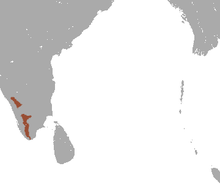Nilgiri langur
| Nilgiri langur | |
|---|---|

| |
| Nilgiri langur eating fruit | |
| Scientific classification | |
| Domain: | Eukaryota |
| Kingdom: | Animalia |
| Phylum: | Chordata |
| Class: | Mammalia |
| Order: | Primates |
| Suborder: | Haplorhini |
| Infraorder: | Simiiformes |
| Family: | Cercopithecidae |
| Genus: | Semnopithecus |
| Species: | S. johnii
|
| Binomial name | |
| Semnopithecus johnii (J. Fischer, 1829)
| |

| |
| Nilgiri langur range | |
| Synonyms[2] | |
| |
The Nilgiri langur (Semnopithecus johnii)
Taxonomy and classification
The classification of the Nilgiri langur has been disputed. Traditionally it has been placed within the genus Trachypithecus based on morphological similarities such as cranial morphology and neonatal pelage color, and within the Trachypithecus vetulus group within Trachypithecus based on a presumed close relationship with the
Distribution
Found in the
Description
The head-plus-body length is 78–80 cm in adult males and 58–60 cm in adult females, with the tail adding between 68.5 and 96.5 cm. The males weigh 9.1-14.8 kg, the females 10.9–12 kg.[4] The gestation period is not precisely known but assumed to be similar to the closely related Hanuman Langur, i.e. 200 days.[4]
References
- ^ . Retrieved 19 November 2021.
- OCLC 62265494.
- ^ a b "Semnopithecus johnii". ITIS Report. ITIS. Retrieved 18 January 2020.
- ^ a b c Malviya, M.; Srivastav, A.; Nigam, P.; Tyagi, P. C. (2011). "Indian National Studbook of Nilgiri Langur (Trachypithecus johnii)" (PDF). Wildlife Institute of India, Dehradun and Central Zoo Authority, New Delhi.
- ISBN 978-8496553897. Retrieved 30 August 2018.
- PMID 18298809.
- S2CID 29045930.
- PMID 22558416.
- PMID 18191589. Retrieved 30 August 2018.
- ^ Govt of India (27 October 2020). The Gazette of India (PDF). Govt. of India. p. 20. Retrieved 14 April 2022.

